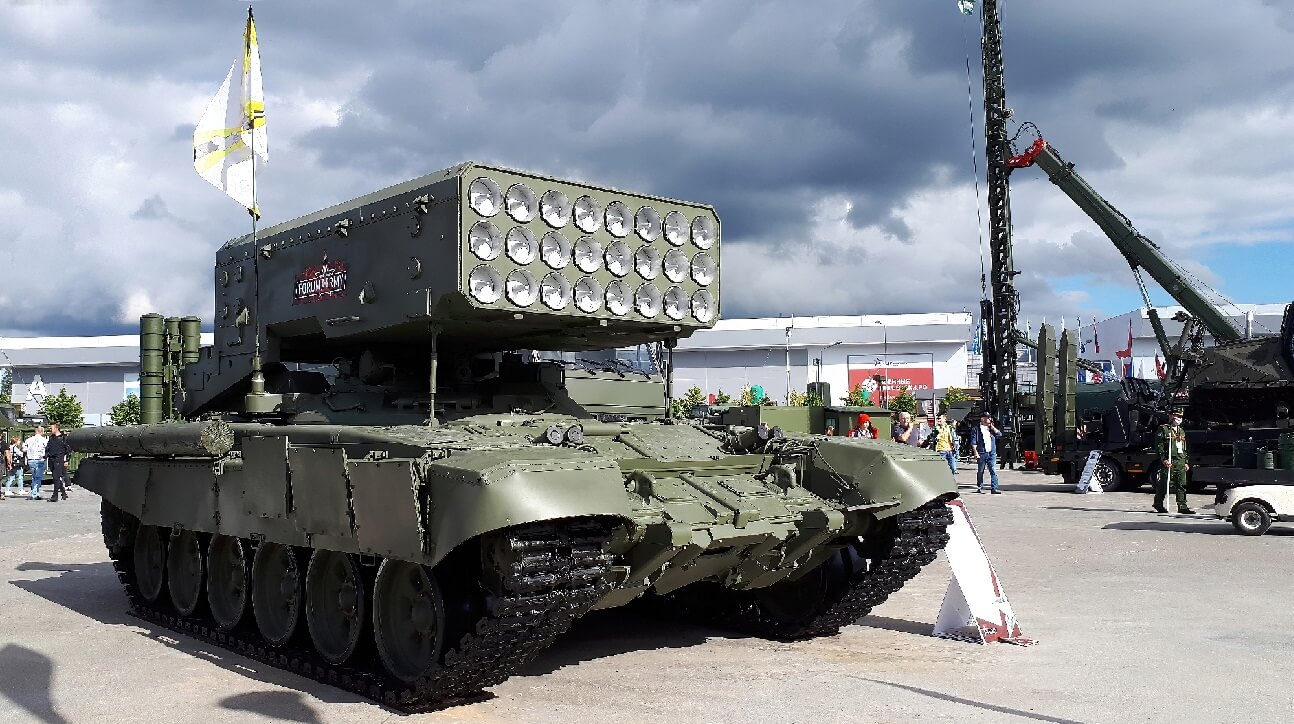As the Russia-Ukraine war intensifies, Moscow is likely to deploy TOS-1A “heavy flamethrower” to increase its firepower in the ongoing invasion of Ukraine. One TOS-1A multiple rocket launcher was spotted on the back of a lorry south of Russia’s Belgorod, near the Ukrainian border, on February 26.
The system equipped with a rack of incendiary or thermobaric rockets is designed to destroy any object it comes across. The Soviets called this a “heavy flamethrower.”
Cameras installed on the Belarus-Ukraine border first captured a TOS-1A among other military vehicles on February 24, the day Russia unleashed its large-scale attack on Ukraine.
Fresh videos of TOS-1As and other heavy weaponry going toward Ukraine began appearing on social media on February 26. This time, though, they were moving south from Russia’s Belgorod region, CNN reported. The TOS-1 “Buratino” and TOS-1A “Solntsepek” are two of the most fearsome weapons in modern warfare.
https://twitter.com/theragex/status/1497532898412572672?s=20&t=3KeC4hQPI6nMJWGXo2ogiQ
Military equipment entering Ukraine in the video from cameras installed at the Belarusian-Ukrainian checkpoint “Senkovka-Veselovka”. These are: the TOS-1A “Solntsepyok”, at least 4 T-72B tanks, at least 8 MT-LB tractors, and Ural truck
All the equipment is marked with “O”. pic.twitter.com/3oIg0zAVuo— Belarusian Hajun project (@Hajun_BY) February 24, 2022
https://twitter.com/theragex/status/1497532898412572672?s=20&t=3KeC4hQPI6nMJWGXo2ogiQ
Defense and national security commentator Charlie Gao said, “The Buratino and Solntsepek are very useful weapons for a military that might be going into urban combat with little regard for collateral damage.”
Social media posts speculated the TOS-1A may have been used in the most recent artillery strike on Vasylkiv, about 15 miles south of Kyiv. There was a massive explosion at the Vasylkiv Air Base, which some interpreted as proof of the TOS-1A’s deployment.
Furthermore, on February 28, the Ukrainian Ambassador to the United States, Oksana Markarova, stated that Russia had used a “vacuum bomb” (thermobaric weapon) in Ukraine.
Russia-Ukraine War
The TOS-1 and TOS-1A were conceived as a long-range alternative to handheld flamethrowers. The weapon is meant to target or crush any object on its course. The launch unit was given the name Buratino, a long-nosed Pinocchio-like character in a children’s story, because of its prominence.

The TOS-1A “Solntsepek” (Sunshine) is an upgraded variant. It is designed to deploy longer-range rockets capable of hitting targets up to 6 kilometers away.
In the past, the Russian military has used the self-propelled multiple rocket launcher system (MRLS) in Afghanistan, Chechnya, Iraq, and Syria. The TOS-1 is designed to annihilate severely fortified sites.
The breakaway Russian province’s capital Grozny was razed to the ground during the Second Chechen War between 1999 and 2000, using this deadly weapon.
Sebastien Roblin wrote in The National Interest, “The TOS-1 vehicle has no real counterpart in use by Western militaries. While there are all kinds of multiple-rocket launch systems in use, such as the M142 HIMARS in use by the U.S. Army to bombard ISIS in Iraq, they are all lightly armored weapons intended for long-range indirect fire.”
The armored launcher has a 360-degree movement with no limits. It is mounted on a tank chassis to maintain pace with the armored troops it’s supposed to support. It has a far lower range than designated artillery to keep flight times minimal.
The Buratino’s secondary function is to employ incendiary rockets to eliminate possible biological or chemical threats; as a result, it is deployed to Russian CBRN flamethrower battalions. The Buratino was developed in the 1970s, deployed in 1980, and saw the first battle in 1988 during the Soviet invasion of Afghanistan.
Sebastian Roblin, a military expert, said: “A TOS-1 rocket barrage will wipe out everything within the 200-by-300m blast zone.”
“Victims near the center of a TOS-1 blast radius are crushed to death. Further out, the overpressure can break bones, dislocate eyes, cause internal hemorrhaging, and rupture eardrums, bowels and other internal organs. It also sucks the air out of victims’ lungs, possibly causing them to collapse, leading to death by suffocation,” he added.
While Russia has deployed this lethal weapon to Ukraine, the extent to which it will be used depends largely on the outcome of the fight in the days and possibly weeks ahead.
- Contact the author at ashishmichel@gmail.com
- Follow EurAsian Times on Google News